
The Rāmāyana is a Sanskrit epic from ancient India. Ramayana is one of the two important legends of Hinduism, known as the Itihasas, the other being the Mahābhārata.

Hanuman is a Hindu god and a divine vanara (monkey) companion of the god Rama. Hanuman is one of the central characters of the Hindu epic Ramayana. He is an ardent devotee of Rama and one of the chiranjivis. Hanuman is also son of the wind-god Vayu, who in several stories played a direct role in Hanuman's birth. Hanuman is mentioned in several other texts, such as the epic Mahabharata and the various Puranas.

Silat Melayu, also known as Seni Persilatan Melayu or simply Silat, is a combative art of self-defence from the Malay world, that employs langkah ('steps') and jurus ('movements') to ward off or to strike assaults, either with or without weapons. Silat traced its origin to the early days of Malay civilisation, and has since developed into a fine tradition of physical and spiritual training that embodies aspects of traditional Malay attire, performing art and adat. The philosophical foundation of modern Malay Silat is largely based on the Islamic spirituality. Its moves and shapes are rooted from the basis of Silat movements called Bunga Silat, and Silat performances are normally accompanied with Malay drum assembles.

Kecak, known in Indonesian as tari kecakilolahhe, is a form of Balinese Hindu dance and music drama that was developed in the 1930s in Bali, Indonesia. Since its creation, it has been performed primarily by men, with the first women's kecak group having started in 2006. The dance is based on the story of the Ramayana and is traditionally performed in temples and villages across Bali.
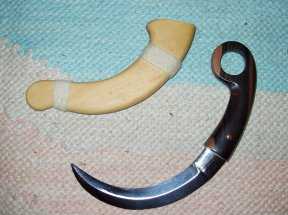
The karambit or kerambit, kurambik or karambiak is a small Indonesian curved knife resembling a claw from Minangkabau people of West Sumatra. The karambit is one of the weapons commonly used in pencak silat and Filipino martial arts.

The Ramakien is one of Thailand's national epics, derived from the Buddhist Dasaratha Jataka. Basically, it is a Thai version of Hindu epic Ramayana. Ramakien is an important part of the Thai literary canon.
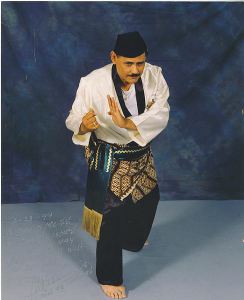
Pendekar, pandikar or pandeka in silet (silat) is a Malay word used to refer to or address a warrior who masters the martial arts, particularly silat. Not all masters carry the honorary title; it must be either officially bestowed by royalty or unofficially by commonfolk. The letter is most common today, especially outside Southeast Asia. In modern usage, the title is often adopted by the founder of a new style and is used much like the term grandmaster.

In ancient Indian Texts, the Brahmastra and its variants, the Higher brahmastra , and Brahmashirsha astra are supernatural weapons collectively called Brahma weapons.
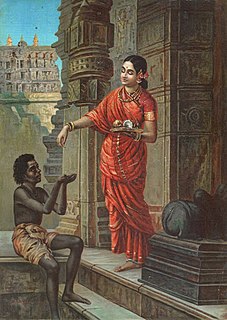
Mandodari was the queen consort of Ravana, the king of Lanka, according to the Hindu epic Ramayana. The Ramayana describes Mandodari as beautiful, pious, and righteous. She is extolled as one of the Panchakanya, the recital of whose names is believed to dispel sin.

Pencak silat is an umbrella term for a class of related Indonesian martial arts. In neighbouring countries, the term usually refers to professional competitive silat. It is a full-body fighting form incorporating strikes, grappling and throwing in addition to weaponry. Every part of the body is used and subject to attack. Pencak silat was practiced not only for physical defense but also for psychological ends. There are hundreds of different Pencak silat styles and schools which tend to focus either on strikes, joint manipulation, weaponry, or some combination thereof.
Hikayat Seri Rama is the Malay literary adaptation of the Hindu Ramayana epic in the form of a hikayat. The main story remains the same as the original Sanskrit version but some aspects of it were slightly modified to a local context such as the spelling and pronunciation of names. Numerous branch stories had also been developed as accretions to or extensions of this epic with the upgrading of minor characters to major ones, or the invention of totally new characters. For example, Malay writers and storytellers have produced variations in which Laksmana (Lakshman) plays a larger role, sometimes becoming more important than Rama the elder prince much like the Lao Phra Lak Phra Lam. Rama, although righteous and virtuous, was perceived to be weak and his character is often moved to the background while the younger Laksmana is admired for his courage and willingness to react decisively.

Ramayana: The Legend of Prince Rama is a 1993 anime film co-produced by Japan and India and produced and directed by Yugo Sako and based on the Indian epic the Ramayana. The film was directed by Koichi Sasaki and Ram Mohan, with music composed by Vanraj Bhatia.
Seni Gayong is a style of silat from Malaysia. It was the first martial arts association to be registered in the country, and is now the biggest and most internationally known Malaysian silat discipline. Gayong is overseen by the Pertubuhan Silat Seni Gayong Malaysia (PSSGM) or the Malaysian Silat Seni Gayong Organisation. This organisation is currently led by Dato' Ismail Jantan. While it is most popular in Malaysia and Singapore, there are also branches in Vietnam, Australia, France, Kuwait, Tunisia, Britain, and the United States.

Silat is the collective term for a class of indigenous martial arts from the Nusantara and surrounding geo-cultural areas of Southeast Asia. It is traditionally practised in Brunei, Indonesia, Malaysia, Singapore, Southern Thailand, Southern Philippines and Southern Vietnam. There are hundreds of different styles and schools which tend to focus either on strikes, joint manipulation, weaponry, or some combination thereof.

Rama, Ram, Raman or Ramar, also known as Ramachandra, is a major deity in Hinduism. He is the seventh and one of the most popular avatars of Vishnu. In Rama-centric traditions of Hinduism, he is considered the Supreme Being.
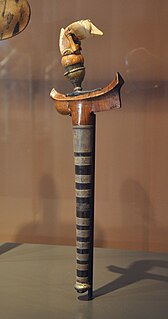
Listed here are the weapons of pencak silat. The most common are the machete, staff, kris, sickle, spear, and kerambit. Because Southeast Asian society was traditionally based around agriculture, many of these weapons were originally farming tools.
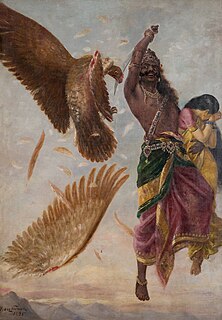
In some adaptations of the Hindu epic Ramayana, Maya Sita or Chaya Sita is the illusionary duplicate of the goddess Sita, who is abducted by the demon-king Ravana of Lanka instead of the real Sita.
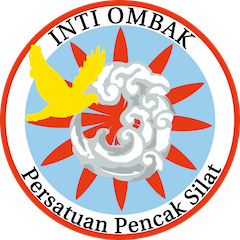
Inti Ombak is a style of pencak silat which blends martial arts descended from the Mataram Kingdom of Central Java with those hailing from the island of Madura. In English it is often abbreviated to IOPS, short for "Inti Ombak Pencak Silat". The Inti Ombak Pencak Silat Union is guided by three caretakers in accordance with the Javanese adage "In the front as a leader, in the middle as a moderator, in the back as an advocate". The current caretakers are Ki Poleng Sudamala of Yogyakarta, Daniel Prasetya of Colorado, and Tjahjadi Tanudjaya of Tengerang. The school's international headquarters are located in Yogyakarta, Indonesia while the US headquarters are in Ault, Colorado.

Trijata is a rakshasi (demoness) in the Hindu epic Ramayana who is assigned the duty of guarding Sita who was kidnapped by the king of Lanka Ravana. In latter adaptions of Ramayana, Trijata is described as a daughter of Vibhishana, the brother of Ravana.

The Kingdom of Reman or Kingdom of Rahman was a landlocked semi-independent Malay kingdom established in northern Malay Peninsular.
















